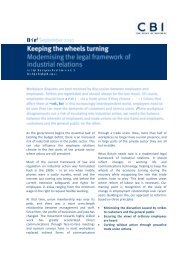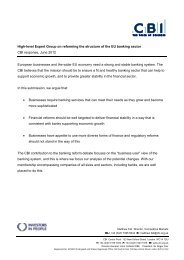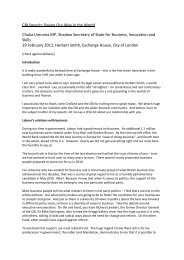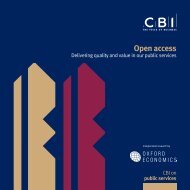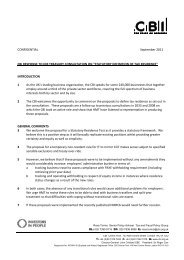CBI response to CRC consultation
CBI response to CRC consultation
CBI response to CRC consultation
You also want an ePaper? Increase the reach of your titles
YUMPU automatically turns print PDFs into web optimized ePapers that Google loves.
For purely fiscal reasons, a time-limited tax is unavoidableThe Office for Budget Responsibility estimates that by 2016-17 the <strong>CRC</strong> will be raising £1.1 billion a year. 3The Government has made clear that the revenue collected through the <strong>CRC</strong> is instrumental <strong>to</strong> repairingthe public finances, and that if this revenue were lost other taxes would have <strong>to</strong> be introduced, or existingtax rates raised, <strong>to</strong> compensate. Any such option would necessarily involve some redistribution of the taxburden, affecting businesses which are not currently part of the <strong>CRC</strong>.For these purely fiscal reasons, the <strong>CBI</strong> believes that the Government should, simultaneously with scrappingthe current <strong>CRC</strong> scheme, introduce the simplest possible method for collecting the same amount ofrevenue from the same businesses currently eligible <strong>to</strong> pay the <strong>CRC</strong>.The mindset with which this tax is designed should not be <strong>to</strong> start from the existing <strong>CRC</strong> and modify it.Rather, it should be <strong>to</strong> strive for the simplest approach that would be designed if starting from scratch. Thisis likely <strong>to</strong> involve:Retaining the current eligibility criteria based on electricity bill size and participation in otherpolicies.Removing all allowance purchase and trading mechanisms and using simple taxation methods <strong>to</strong>collect the revenue.Using the simplest possible method <strong>to</strong> calculate the payment companies are eligible for, based onsimple energy use statistics.Removing all public reporting mechanisms.Primary legislation may be required <strong>to</strong> set up this new approach.As soon as the public finances allow, this tax should be given a high priority for removal. For this reason, thelegislation creating it should include a sunset clause so that once the fiscal situation allows the tax isremoved. We suggest this clause may need <strong>to</strong> be set for three <strong>to</strong> five years’ time from the present.A more strategic approach <strong>to</strong> business energy efficiency is needed, starting with manda<strong>to</strong>ry carbonreportingScrapping the <strong>CRC</strong> would remove an ineffective policy instrument that is presenting a barrier <strong>to</strong> businessenergy efficiency. However, an effective policy framework will still be needed <strong>to</strong> encourage and supportbusiness energy efficiency. Indeed, there are a number of barriers <strong>to</strong> energy efficiency being realised inbusinesses, including upfront cost, payback period, awareness of opportunities, and hassle fac<strong>to</strong>r, that willstill need <strong>to</strong> be overcome. The relative size and nature of these barriers differs from business <strong>to</strong> business,and markedly so between different sec<strong>to</strong>rs and sizes of business. For example, making improvements <strong>to</strong> abuilding requires a different level of investment and has a different payback time <strong>to</strong> altering the way inwhich a process industry company does business.To design an effective business energy efficiency policy framework, a strategic assessment should beundertaken of the barriers and potential policy solutions, designed from the point of view of driving energyefficiency rather than generating revenue. This should lead <strong>to</strong> a proposal or set of proposals which can bedesigned and taken forward in <strong>consultation</strong> with industry.Designing and implementing this framework will, inevitably, take some time, but this is not a reason <strong>to</strong>delay the abolition of the <strong>CRC</strong>. In fact, more effective policies cannot be developed until the <strong>CRC</strong> is gonebecause its existence is acting as a barrier: the government, and stakeholders, do not want <strong>to</strong> discuss newideas because of the risk of adding further policy complexity should the <strong>CRC</strong> not be removed.3 http://budgetresponsibility.independent.gov.uk/wordpress/docs/Fiscal-Supplementary-Tables-AS11.xls3 | P a g e



